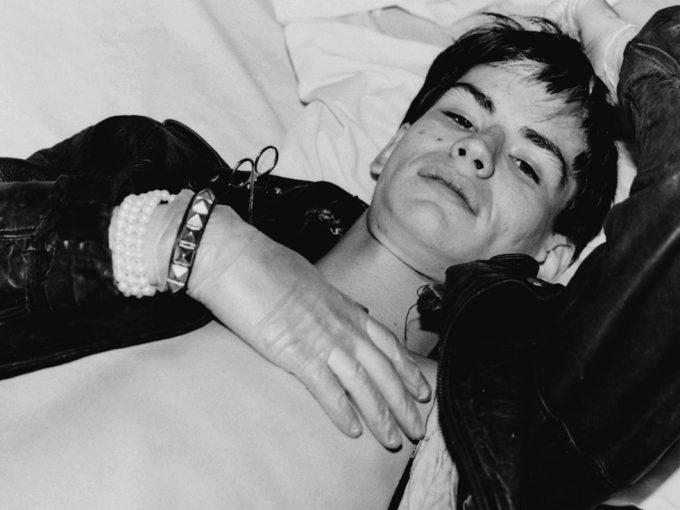Megan “Montana” Smith first met Mark Morrisroe (then self-styled Mark “Dirt”) in the fall of 1977 when both attended the School of the Museum of Fine Arts, Boston, becoming close friends and artistic colleagues at a moment of great creative ferment. At the school innovative visiting artists like Vito Acconci, esteemed teachers such as Bill Burke, and influential alumni such as Jim Dine mingled with a diverse mix of students including Amy Arbus, Nan Goldin, Janet Stein, and David Armstrong. For young photographers, it was a time of experimentation and redefinition, as camerawork evolved from its traditional documentary limitations and hovered on the cusp of fine (rather than applied) art. For this new artistic generation, photography would stand on its own as a means of artistic expression, shedding any pictorialist or narrative intentions, and, significantly, they created photographs intended for a gallery setting.
“We were both enrolled in a plastics sculpture class with Pat Hearn, who was crafting giant insect wings for one of her early performance pieces, ” Smith recalled. “One evening Mark and I were alone in the workshop while he was imbedding a dead rat in liquid Plexiglas. He always liked to remind me later that, although I chattered on and on about the horrendously putrid smell of his dead rat, I never actually left, and so he ‘knew’ that we would be friends. It was both a test and a microcosm of any friendship with Mark: if you weren’t immediately grossed out by his strange eccentricities, he knew he had found a potentially kindred soul. And although we came from very different backgrounds, we were sort of on a similar wavelength at that time, artistically and socially, involving constant art-making, retro style, a lot of Warholesque marathon telephony, bizarre mail, and a generally subversive approach to life in general. For us it didn’t seem strange to shoot five rolls of film after class, write crank letters to famous artists, go to Brigham’s for ice cream, do the Woolworth’s photo booth, walk over to the S&M bar where Mark bartended, then meet up with friends and stay up all night at a Pasolini or horror film fest.”
Working together in the darkroom, both Smith and Morrisroe studied a panoply of traditional B&W, color, and non-silver processes during the late 70s and early 80s, at a time when late night visits to the school might include hanging out in the color darkroom with Nan Goldin or weekend trips to New York where the early “New Wave” scene had exploded into popular culture; intersecting art, music, performance, and film into the emerging downtown gallery scene. Theirs was a shared artistic and social zeitgeist, populated by art students such as Gail Thacker, Pat Hearn, Laurie Olinder, Jack Pierson, Steve “Stain,” Stephen Tashjian, Penelope Place, Tina Summerlin, Shelley Lake, and Mark’s longtime muse and collaborator Lynelle White, along with figures from the Boston “punk” music, performance, and literary scene, whose lives and creativity both influenced and inspired their photographs.
While Morrisroe pursued his artistic career in New York in the later 1980s, continuing to collaborate with fellow students such as gallerist Pat Hearn and performance artist Stephen “Tabboo!” Tashjian, Smith embarked on graduate study in art history, earning an advanced degree, studying European museum collections and eventually holding curatorial posts at the Metropolitan Museum, the Smithsonian, and Harvard University. While photography has always continued as an important thread in her life, she also strives to preserve artistic and documentary material from the so-called “Boston School” era. In 2012 Smith self-published a photo memoir, “Mark Morrisroe: Memento Mori,” based on her portraits of Morrisroe, and she recently contributed an essay to the book “Mark Morrisroe: Mark Dirt” (Paper Chase Press, 2013). She is currently working on a catalogue survey of her early photographs entitled “Montanaland.”


![Click for sizes / editions / prices. Film Noir Mark, Boston, 1980 [Portrait of Mark Morrisroe], Megan "Montana" Smith](https://clampart.com/wp-content/uploads/2013/12/Smith_Film-Noir-Mark-Boston-1980-640x480.jpg)

![Click for sizes / editions / prices. Film Noir Mark, Boston, 1980 [Portrait of Mark Morrisroe], Megan "Montana" Smith](https://clampart.com/wp-content/uploads/2013/12/Smith_Film-Noir-Mark-Boston-1980-366x550.jpg)
